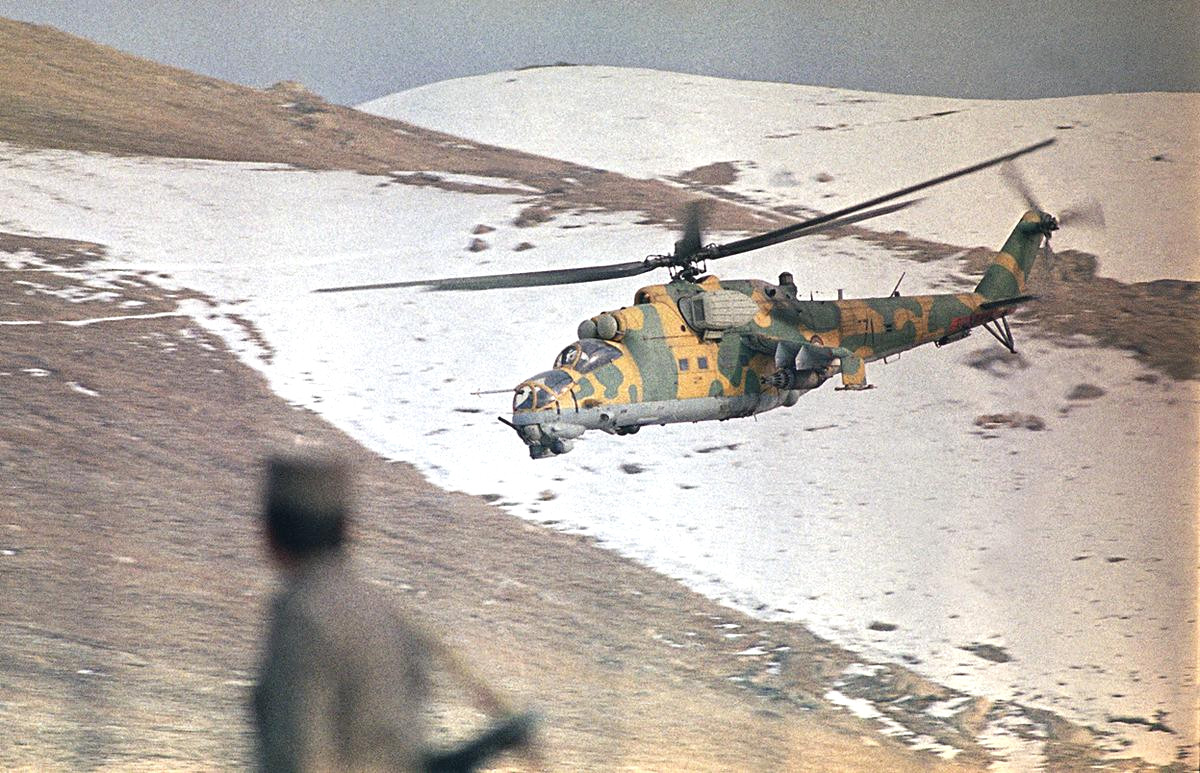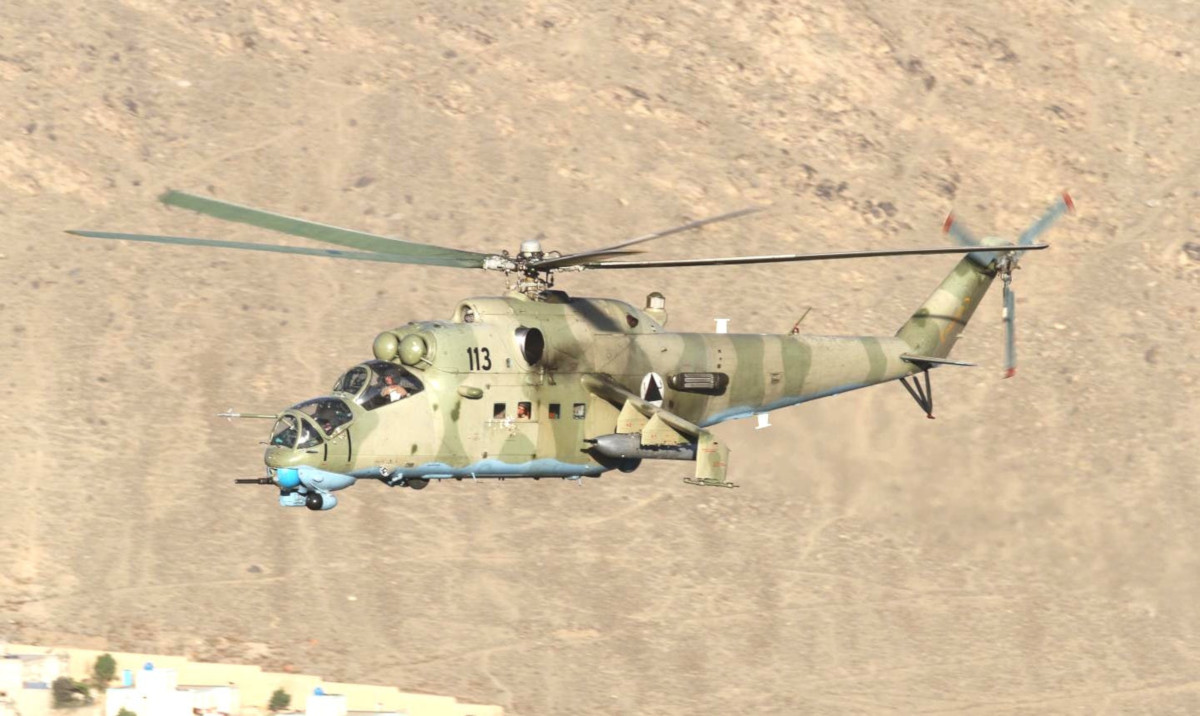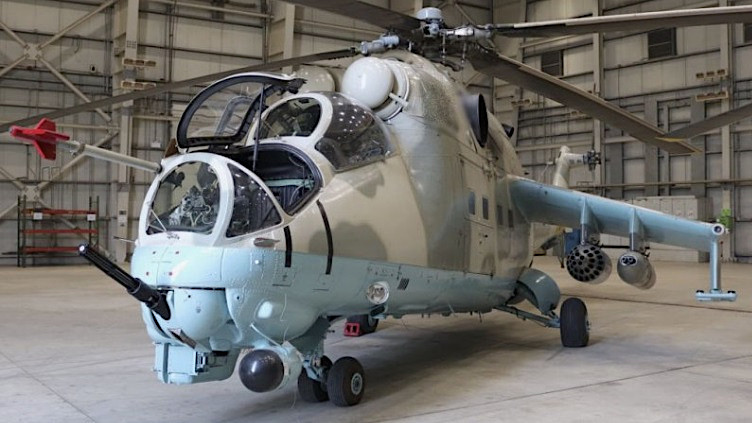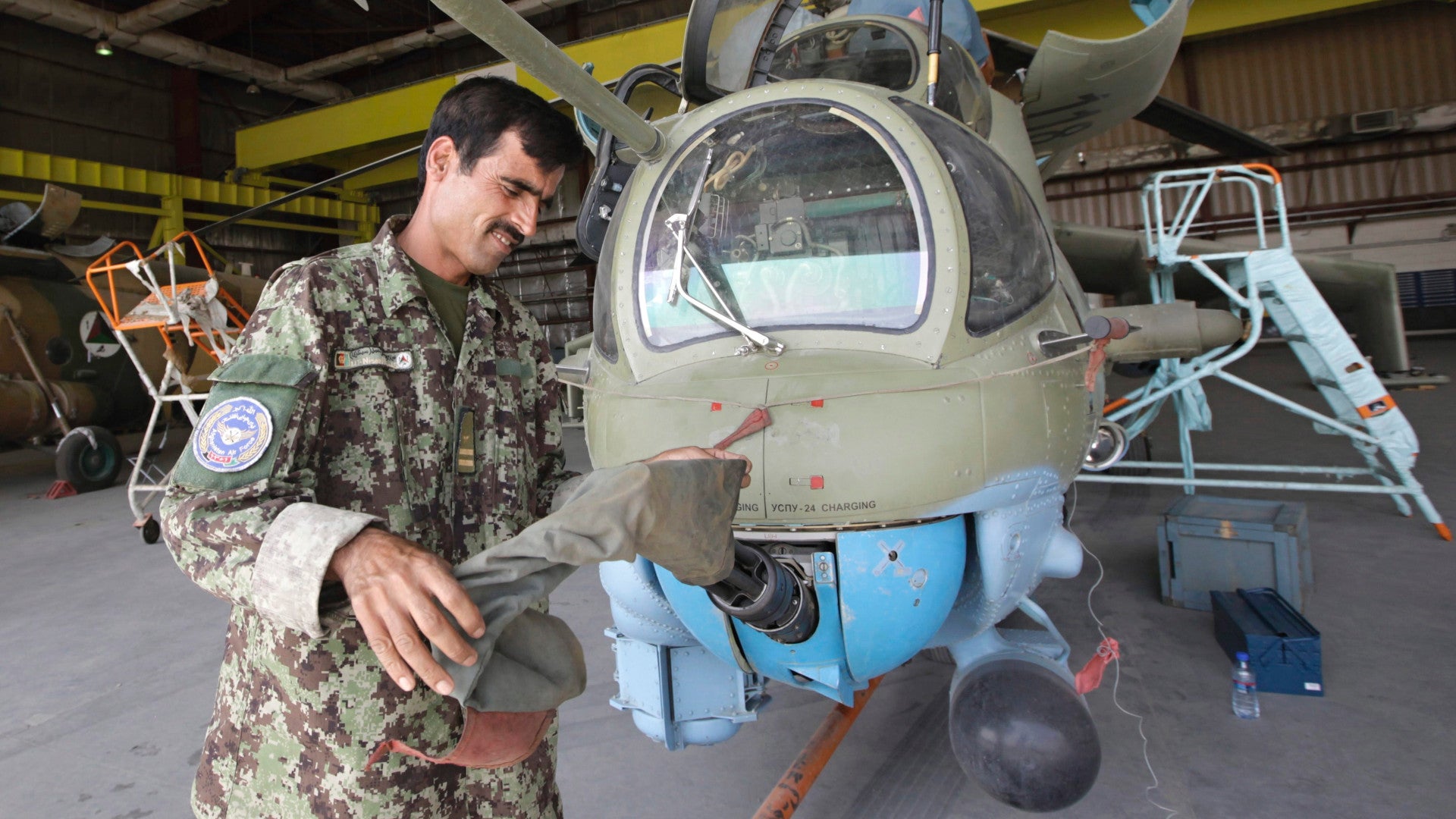The Afghan Air Force’s fleet of four Mi-35 Hind helicopters is grounded and it’s not clear when they might fly again. As far as its American advisors are concerned, the service shouldn’t even have any of the imposing Russian-made gunships anymore and won’t offer any support to get them flying again, but the Afghans continue to resist the push to retire the type for good.
The Pentagon included an update on Afghanistan’s Hinds in its latest Enhancing Security and Stability in Afghanistan report, which it published in June 2019, but only publicly released on July 12, 2019. This is a semi-annual review of the security situation in that country, as well as support from the NATO-led coalition to the Afghan National Defense and Security Forces (ANSDF), which includes both military and national police elements. This latest edition covered the period from Dec. 1, 2018, to May 31, 2019.
“All four [Mi-35] aircraft required their 500-hour inspection and have been grounded until completed,” the report noted. “The AAF is trying to source funding to complete repairs.”
The Hind was an iconic component of the Soviet Union’s war in Afghanistan, which lasted from 1979 until 1989. The country’s nominally independent Soviet-backed military also received dozens of the heavily armed and armored gunships, which also have the unique ability to carry a small number of armed troops, during the conflict.

The helicopters continued to be a feature in the country’s civil conflicts in the years that followed the departure of Soviet forces. By the time of the U.S.-led invasion in 2001, though few were still operational. But, as the NATO-led coalition began to rebuild the country’s military, the Hinds, along with Russian-made Mi-17 Hip armed transport helicopters, became an important component of the reformed Afghan Air Force.
The two helicopters have a certain degree of commonality and are relatively easy to operate and maintain. When it came to Afghanistan, they were also types that many Afghan pilots and ground crews were already familiar with.
But the Pentagon’s latest Afghanistan review only mentions the gunships in a footnote, because the NATO-led coalition and the U.S. military, which is the biggest contributor to that multi-national force, refuse to help the Afghan Air Force with their operation or maintenance. This has been the case since 2015, when Afghan authorities formally removed the Hinds from the service’s official force structure at the urging of their NATO advisors.
“The Mi-35s were removed from the authorized fleet in 2015, but the Afghans continue to attempt to sustain them,” the Pentagon review added. “DoD [the Department of Defense] has advised them against doing so and to instead focus on the aircraft that DoD is providing as a part of the aviation modernization program.”
Leading up to 2015, it had appeared that Afghanistan would have no choice but to give up on its Hinds for good. The Czech Republic had supplied five Mi-35s to the growing Afghan Air Force in 2008, but after seven years of combat operations, they had hit the end of their service life. The United States pushed the country to adopt the smaller MD 530F light attack helicopter.

The stated reason for this was the desire for the Afghans to adopt an attack helicopter platform that was less maintenance intensive and otherwise easier to operate than the aging Hinds. On top of that, after Russia’s seizure and illegal annexation of Ukraine’s Crimea region in 2014, it became increasingly politically untenable for the U.S. government to continue purchasing Russian-made helicopters for the Afghan Air Force and otherwise contracting with Russian suppliers to support them. Subsequent sanctions against the Kremlin only compounded the difficulties, which also had serious impacts on Afghanistan’s Mi-17s, a topic
The War Zone
has covered in-depth in the past.
But in September 2015, Afghan Air Force Colonel Qalandar Shah Qalandari gave The New York Times a scathing interview about the smaller helicopters, commonly known as Little Birds, decrying them as ill-suited to the country’s conditions. “It’s unsafe to fly, the engine is too weak, the tail rotor is defective and it’s not armored,” he declared.
“If we go down after the enemy we’re going to have enemy return fire, which we can’t survive,” he continued. “If we go up higher, we can’t visually target the enemy.”
Qalandari, a Soviet-trained pilot who was, at the time, the country’s most decorated aviator, wanted more Hinds. That same year, India, an increasingly important partner of the Afghan government, stepped in to donate four more of the gunships. These are the ones that are now grounded pending the 500-flight hour inspections.

It is worth noting that the exact capabilities the existing Hinds had provided up until that point had often been questionable, given the small size of the fleet, limited numbers of individuals trained to operate and maintain them, and dwindling spare parts inventories. The gunships did have the range to self-deploy to different forward operating locations around the country, but there was only so much capacity four helicopters could offer across an area just slightly smaller than Texas. Afghan pilots only had very limited abilities to conduct operations at night, too, when the Taliban and other militants and terrorists in Afghanistan are most active.
In June 2015, right around the planned retirement date of the Czech-supplied gunships in 2015, the Pentagon also revealed that Afghan Hind crews had fired unguided 57mm rockets from the helicopters for the first time in more than three years. This appeared to be a restriction NATO advisors had imposed on Afghan pilots to try to reduce civilian casualties. In the intervening period, each of the helicopters had only carried a pair of 23mm gun pods, one slung under the stub wings on either side of the fuselage, in addition to the four-barrel 12.7mm YakB machine gun in their nose turrets.

Now, it’s unclear if the four existing gunships will fly again, but the Afghan Air Force still hasn’t given up on flying Hinds. India is in the process of donating four more. The first two of these helicopters, which came by way of Belarus to avoid violating U.S. sanctions, arrived in May 2019.
“These are a replacement for the four attack helicopters previously gifted by India to Afghanistan in 2015,” the Indian Embassy in the country said in a statement at the time. Indian authorities specifically said that the gunships would help in “combating the scourge of terrorism.”

In 2018, The Diplomat had reported that an Indian team had also conducted an assessment of the Afghan Air Force two years earlier and concluded that it would take $50 million to rehabilitate another 11 Hinds that remain in storage, as well as seven unspecified transport helicopters, likely Mi-17s. It is unclear if this total includes the five Hinds the Czech Republic had supplied nearly a decade ago. There have been separate reports that India and Russia might have reached an agreement to help maintain Afghanistan’s Russian-made helicopter fleets, though this could risk triggering U.S. sanctions.
Somewhat curiously, the U.S. government has been a major advocate for India increasing its support Afghanistan, even as it pushes the Afghan Air Force to abandon the Hinds. The United States continues to deliver MD 530Fs and, regardless of any shortcomings, have been flying steadily increasing numbers of combat sorties in recent years. However, contractors continue to provide 80 percent of the required maintenance and logistics support of these helicopters.

The U.S. military now has plans to eventually supply the Afghans with an armed version of the UH-60A+ Black Hawk. The United States is already in the midst of a deeply controversial plan to replace the Afghan Air Force’s Mi-17s with Black Hawks.
In recent years, the U.S. government has also been facilitating steady deliveries of A-29 Super Tucano light attack aircraft to further bolster the Afghan Air Force’s close air support capabilities. AC-208 Eliminator light attack aircraft are now entering Afghan service, as well.
But, if the past five years are any indication, the Afghan Air Force is likely to continue flying Hinds, even in a limited capacity, for the foreseeable future. With India’s help, the service may even be able to increase the size of this “unauthorized fleet.”
Contact the author: joe@thedrive.com
